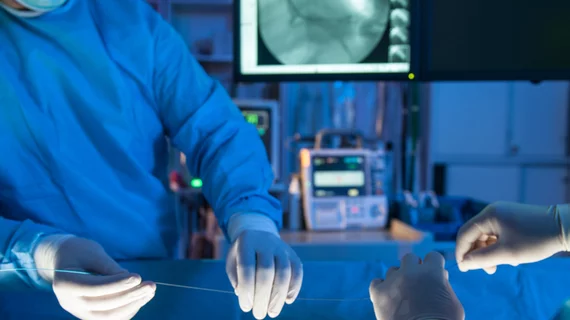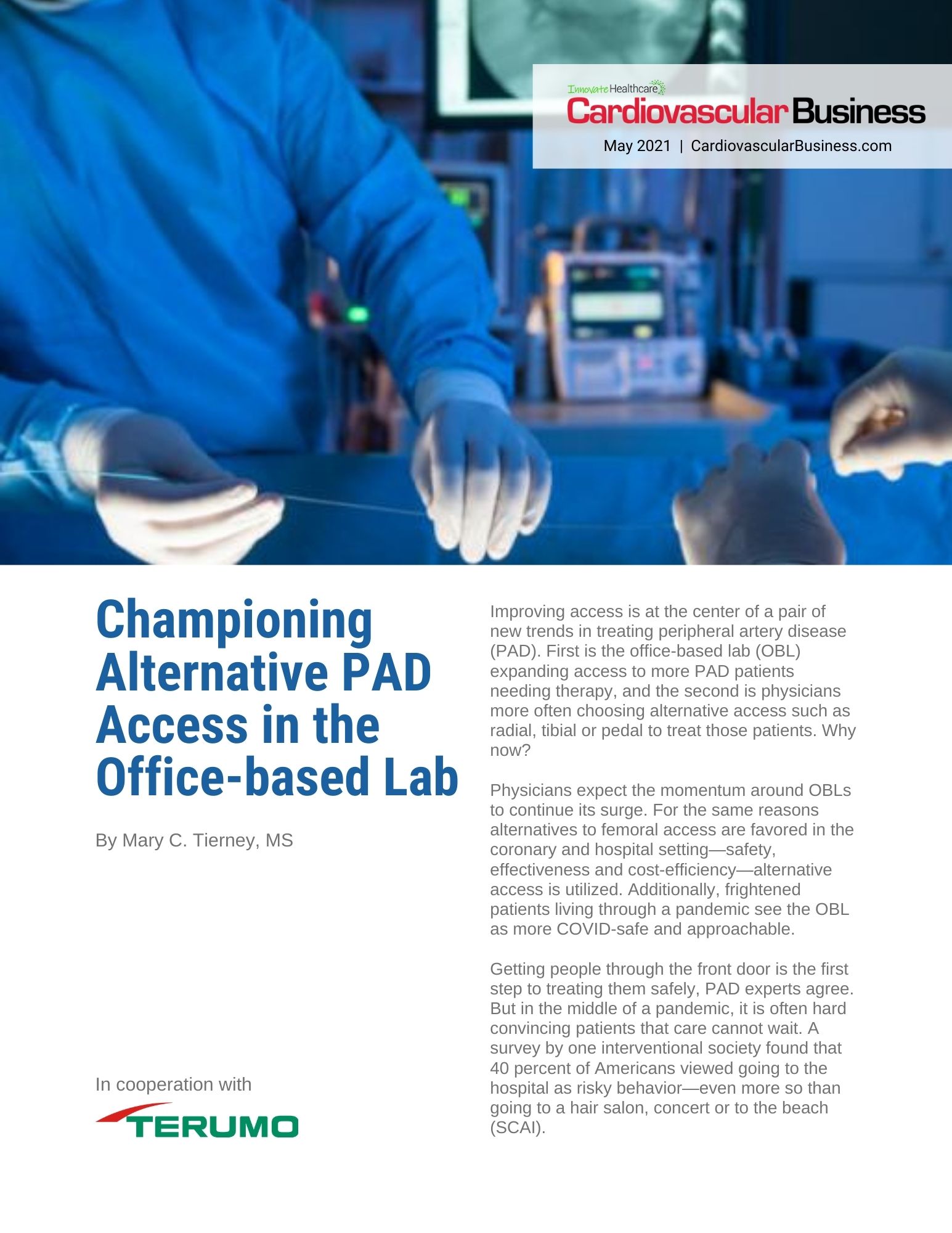Championing Alternative PAD Access in the Office-based Lab
Improving access is at the center of a pair of new trends in treating peripheral artery disease (PAD). First is the office-based lab (OBL) expanding access to more PAD patients needing therapy, and the second is physicians more often choosing alternative access such as radial, tibial or pedal to treat those patients. Why now?
Physicians expect the momentum around OBLs to continue its surge. For the same reasons alternatives to femoral access are favored in the coronary and hospital setting—safety, effectiveness and cost-efficiency—alternative access is utilized. Additionally, frightened patients living through a pandemic see the OBL as more COVID-safe and approachable.
Getting people through the front door is the first step to treating them safely, PAD experts agree. But in the middle of a pandemic, it is often hard convincing patients that care cannot wait. A survey by one interventional society found that 40 percent of Americans viewed going to the hospital as risky behavior—even more so than going to a hair salon, concert or to the beach (SCAI).
“This is no joke, patients are afraid of hospitals,” says Chris LeSar, MD, a vascular and endovascular surgeon who founded the Vascular Institute of Chattanooga, an OBL, five years ago. “We as physicians know they’re not coming in as often for care as they truly need. We also know it’s far easier to convince an anxious patient to come into our lab when we talk about effective procedures that will fix their problem and the good outcomes patients have here. Being smaller and only needing to be here for a short time both make them feel safer.”
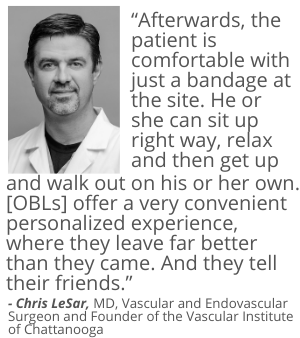 To LeSar, effectiveness drives back to alternative access. Doing the best procedure, with low risk of bleeding, starts with choosing the right access point. “Afterwards, the patient is comfortable with just a bandage at the site. He or she can sit up right away, relax and then get up and walk out on his or her own. [OBLs] offer a very convenient personalized experience, where they leave far better than they came. And they tell their friends.”
To LeSar, effectiveness drives back to alternative access. Doing the best procedure, with low risk of bleeding, starts with choosing the right access point. “Afterwards, the patient is comfortable with just a bandage at the site. He or she can sit up right away, relax and then get up and walk out on his or her own. [OBLs] offer a very convenient personalized experience, where they leave far better than they came. And they tell their friends.”
That also explains the high marks OBLs are getting for patient satisfaction and healthy patient volumes, even during the pandemic. Data shows fewer complicationswith fewer handoffs among caregivers and departments, fewer access site complications with radial artery access vs. femoral, and lower patient co-pays with reduced overall procedure cost vs. a hospital-based pricing.
We’ve seen a surge in office-based interventional suites over the past 4 years. The Outpatient Endovascular and Interventional Society (OEIS) puts the number of office-based labs in the United States at about 700—and growing. In addition to a focus on patient experience and good outcomes, many see their services as more efficient and cost effective than many hospital-based interventions. Savings come from reduced overhead and streamlined business operations.
Technology, tools & talent
From the inside looking out, physicians say technology, techniques and people are the differentiators of OBL care. Think ultrasound image-guidance, smaller sheaths, ongoing staff training and fierce independence as standards of care.
More OBLs are embracing radial, pedal and other alternative routes to treat PAD and reduce vascular complications. The obvious dilemma in patients who present with PAD is the tendency to have diffuse disease with an inherent risk of vascular bleeding. Total aortic occlusion or severe iliac disease are not unusual, making the groin approach difficult, if not nearly impossible. Avoiding the groin is best for the patient that is older and less mobile. With radial access, there is less recovery time and increased patient comfort.
“Good outcomes and safety are closely linked to the tools and staff we surround ourselves with,” says Jihad Mustapha, MD, who is president and CEO and director of endovascular interventions at Advanced Cardiac & Vascular Centers for Amputation Prevention that has outpatient centers in Michigan and Nevada. “That is what allows us to do these procedures very safely and very efficiently.”
Mustapha and LeSar are strong advocates of proliferating alternative access in the OBL space, as is Ankur Lodha, MD, who is an interventional cardiologist, medical director of OBL for Cardiovascular Institute of the South in Lafayette, La., and heavy peripheral operator.
Topping the list of benefits OBLs offer, the physicians cite, are fewer complications, better patient safety and meeting patient preference to stay out of hospitals. All three also see a turning tide, with the rise of the OBL using alternative access to offer patients good outcomes and keep them out of the hospital.
With safety and efficacy top of mind, alternative access should be the primary choice for patients with critical limb ischemia (CLI), says Mustapha whose case mix includes 90% CLI cases. “Without it, physicians are putting patients at risk for higher complication rates. The highest and most uncomfortable complication is artery perforation which can lead to compartment syndrome and some severe outcomes. Alternative access is a way to avoid those complications…The minute you add alternative access, you have a 60-70% increase in success rates.”¹
Lodha sees 95 to 100% radial access as appropriate in the office-based lab so patients can go home soon after procedures and aren’t worried about groin issues and closure devices. “That also allows us to do more cases per day,” he says. “Economically, you save money on these cases as they have low-risk access without need of expensive closure devices and potential access-related complications that have significant healthcare cost associated with them. And when it's your own lab, you're very judicious about the products you open. There is less waste for sure.”
Most labs are using high-definition ultrasound and skilled vascular sonographers to help guide the best vessel access and planning exit strategies before physicians enter. That speaks to technology in the OBL space as well as the need for a core group of well-trained nurses, techs and support staff. “We have more devices and use leading edge techniques in our labs—and are very efficient at using them,” says LeSar. “Our teams also are skilled at prepping the entire leg instead of just the groin.” 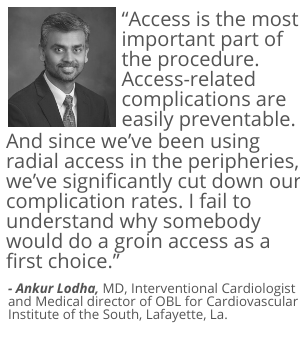
He speaks to the importance of staff training and consistency over time. And once the team is skilled and efficient, their appreciate grows around the value of less invasive procedures so patients can safely walk out of the center an hour later having had their problem fixed. Technique is key too.
“More slender sheaths from Terumo allow us better access,” says LeSar who favors tibial access where the risk of bleeding is lower. “The sheaths improve our success and safety profiles. They’re designed well and very valuable and definitely have changed my care practice. I used to do about 90% of cases using femoral or superficial femoral approach, now it's the other way around with 90% ankle approach.”
Mustapha agrees on the safety and efficacy benefits. “Terumo has provided us with some of the tools that allow us to cross using a low profile access and cross CTOs better,” he says. “Access and crossing an occlusion are the two steps that previously caused the majority of complications. Now we have the most effective elements of control which leads to the lowest rate of complications.”
No matter the acuity of the patient, Lodha sees access central to procedure success or failure. “Access is the most important part of the procedure,” he says. “Access-related complications are easily preventable. And since we’ve been using radial access in the peripheries, we’ve significantly cut down our complication rates. I fail to understand why somebody would do a groin access as a first choice.”
Lessons from COVID-19
No discussion in 2021 is complete without a bow toward the pandemic. It’s definitely been a bumpy road with many patients delaying care and interventions because they’re afraid of the virus. Patients were and still are sicker and presenting with more significant symptoms having put off care. OBL volumes dipped significantly during March, April and May largely because patients weren’t being seen in clinics. They also weren’t walking as much at home and thus complaining of leg pain or claudication.
Many patients were sitting at home too scared to even complain because they weren’t sure if they would be ready for a procedure. “Cases went from 80 to 85 a month to 60 or so for a couple of months, many quite urgent,” Lodha says. “We also saw physicians offering more medical management and less aggressiveness in treatment than pre-COVID. [In early 2021,] patients are still fearful and providers seem to be testing less but cases are climbing back to a more regular case mix.”
LeSar’s group also has seen a lot of late presentations of advanced disease too—which cuts the chances of saving a life in half. And even though they're an amputation prevention center, they had about a 200% increase in amputations because people we not coming in properly. “They also didn’t move as much, smoked more and many gained weight,” he says.
Acuity remains high among patients being treated in OBLs. Cases are more complex as are the wounds that come from arterial problems because of venous issues.
Mustapha echoes the same problems. “We’ve seen the sickest patient populations ever, and more of them,” he says. “Most patients waited at home so long, many with gangrene, and the ER was not taking patients like this. Family care physicians found us and sent patients our way. We’ve avoided many amputations.”
But from the pandemic has come some good. Minds were opened. Doctors realized patients needed urgent care and rerouted them to OBLs. “We have the capacity and flexibility,” Lodha says. “With [COVID] we adapted quickly with PPP, staff and safety training. For a while now there has been a desire in society to keep people out of the hospital. The pandemic sped that up. Physicians now see OBLs differently, I believe, in having adapted and stayed open to help patients. And the results are good for our patients.”
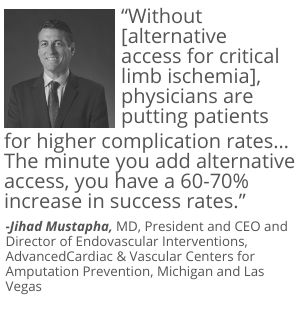 OBL physicians and staff also learned the value of being able to focus on one patient at a time, Mustapha notes. “Imagine if you're a patient,” he says, “it is a phenomenal feeling being the only person being taken care of. The procedure is underway in 10 to 15 minutes, then you’re going home an hour after your procedure is complete. We’re not trying to make it too quick but with alternative access it can be quick and very successful. It’s a new way of thinking.”
OBL physicians and staff also learned the value of being able to focus on one patient at a time, Mustapha notes. “Imagine if you're a patient,” he says, “it is a phenomenal feeling being the only person being taken care of. The procedure is underway in 10 to 15 minutes, then you’re going home an hour after your procedure is complete. We’re not trying to make it too quick but with alternative access it can be quick and very successful. It’s a new way of thinking.”
This focus on patients is why OBLS will thrive and grow. The physicians agree that the elderly population is no longer interested in being in a hospital. “Outpatient facilities are the future of healthcare when it comes to treating vascular disease,” Mustapha says. “Yes, there is sometimes a patient who needs to be in a hospital but that is a very small percentage for the types of procedures we do.”
Lodha sees OBLs flourishing too. “There are more OBLs opened in this country right now than there were two years ago,” he says. “The trend is going to just keep going on. Those patients in OBLs are going to be done radially. Financially it benefits Medicare, insurance companies, doctors and patients because the cost of performing the procedure in the OBL is far less compared to the same procedure in a hospital. Also Medicare patient may not have to pay 20% of the hospital bill but pay 20% of the OBL which is far less.”
OBLs also appeal to physicians’ entrepreneurial instincts, offers more autonomy, allows them to manage their own schedules. For LeSar, it was logjams in care that ultimately motivated him to push into the OBL space. “It took weeks or a month or two to get into our office,” he says. “That was not good for patients at all. We decided to do something different and break those barriers down. Now we get patients into our office within three days.”
Is it better financially for physicians? “Sometimes,” LeSar notes. “I don’t see this as a financial move. But I am far more satisfied with my case mix, how rapidly we can get people in and care for them.”
But the focus must always be on OBL teams and patients. “This is not a place just to make money. You have to have a passion to do this to help patients. Thousands of legs are saved every year across the country with some really great doctors. That offers us great peace of mind.”
Clarity of purpose is a motivator too. After a dozen years as a vascular surgeon in academic practice, LeSar opened an OBL because he wanted to find a better model for both patients and physicians. “Having tried to fix everything I could fix, I decided to start over.”
There’s no stopping us now
OBLs, even mid-pandemic, are taking good care of patients. As patients come to experience the convenience of OBLs, and share with family and friends, and as payors discover cost savings OBLs offer, the pendulum is shifting to favor the OBL.
Patients bring patients. “When I started doing radial peripheral interventions, I soon realized I'm was getting a lot of referrals back from patients themselves,” Lodha says. “Patients are our advocates for sure. That is how we know the procedures we do are helping their lives and they want others with the same problems to have get the procedures they need too.”
Nurses are very important too to building business. “A lot of my clinic nurses were fascinated by the great stories had of their experience and successful procedure,” he says. “The nurses would talk about it to other doctors who now either refer patients to me or do radials themselves.”
The business landscape is very positive. Despite the myriad challenges of COVID and patients sometimes not showing up, LeSar’s practice has grown 20% over the last year in volume, revenue and employees. “I believe 80% of vascular care can now be delivered in an outpatient world.”
Excellence in patient care and safety must be the top priorities, the physicians agree. “It's challenging to set up an OBL but very rewarding,” LeSar says. “Soon we'll see cardiac catheterization and coronary stenting in the outpatient world. This is all coming because we're able to do things safer now, and the technology has really allowed us to transition the field of care to a more direct consumer.”
Outpatient centers are the future to Mustapha, too. “This is the future of interventions,” he says. “We must always focus on improving access with our interventions as well as offering more access and opportunities to patients. That is where the OBL fits perfectly within healthcare.”
Lodha’s final piece of advice goes to physicians: Now is the time to get involved in the OBL space. “If you’re the first in town or not, you're part of a unique group right now. You're going to get instant recognition to help springboard your practice. The future is in smaller packages and smaller footprints.”
- Mustapha JA, Diaz-Sandoval LJ. Jaff MR, Adams G, Beasley R, Finton, S, McGoff T, Miller LE, Ansari M, Saab F; Ultrasound-Guided Arterial Access: Outcomes Among Patients with Peripheral Artery Disease and Critical Limb Ischemia Undergoing Peripheral Interventions. J of Invasive Cardiol. 2016 Jun;28(6):259-64.
